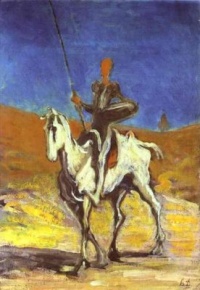Honoré Daumier
From The Art and Popular Culture Encyclopedia

|
"Another independent was Honoré Daumier (1808-1879), who for forty years satirized Paris by his lithographs in Charivari, and in the meantime painted a few pictures. His daily task of reaching essentials through simplification— -essentials of form to enforce the essential meaning — undoubtedly influenced his painting in the same direction. Within a limited range of color — a color scheme reminiscent of Rembrandt in its tonality of warm browns and yellows — large bold areas of pigment cut highly simplified planes, and every detail is eliminated which does not bear on the central idea. In The Uprising, diagonal planes, moving in from opposite corners by means of sharply contrasted lights and darks, carve out a space filled with a mob, though but a few people can actually be seen. One dynamic figure in the foreground tersely carved in light and dark, with a forceful diagonal movement, repeated in the half-seen figure on the left, symbolizes the threatening mood of the mob. Daumier, like Goya, penetrated deeply into the contemporary life of all classes and represented it in a form that was terse, compelling, and caustically satiric. His means were line of tremendous energy, and forceful oppositions of black and white." --Gardner's Art Through the Ages (1926) by Helen Gardner |


|
Related e |
|
Featured: |
Honoré Daumier (1808 – 1879) , was a French printmaker, caricaturist, painter, sculptor, and one of the most gifted and prolific draftsmen of his time. He is best-known for his satirical work in Le Charivari, and underrated for his work as a painter.
Contents |
Early life
Daumier was born in Marseille to Jean-Baptiste Louis Daumier and Cécile Catherine Philippe. His father Jean-Baptiste was a glazier whose literary aspirations led him to move to Paris in 1814, seeking to be published as a poet. In 1816 the young Daumier and his mother followed Jean-Baptiste to Paris. Daumier showed in his youth an irresistible inclination towards the artistic profession, which his father vainly tried to check by placing him first with a huissier, for whom he was employed as an errand boy, and later, with a bookseller. In 1822 he became protégé to Alexandre Lenoir, a friend of Daumier's father who was an artist and archaeologist. The following year Daumier entered the Académie Suisse. He also worked for a lithographer and publisher named Belliard, and made his first attempts at lithography.
Having mastered the techniques of lithography, Daumier began his artistic career by producing plates for music publishers, and illustrations for advertisements. This was followed by anonymous work for publishers, in which he emulated the style of Charlet and displayed considerable enthusiasm for the Napoleonic legend.
Published works
When, during the reign of Louis Philippe, Charles Philipon launched the comic journal, La Caricature, Daumier joined its staff, which included such powerful artists as Devéria, Raffet and Grandville, and started upon his pictorial campaign of satire, targeting the foibles of the bourgeoisie, the corruption of the law and the incompetence of a blundering government. His caricature of the king as Gargantua led to Daumier's imprisonment for six months at Ste Pelagie in 1832. Soon after, the publication of La Caricature was discontinued, but Philipon provided a new field for Daumier's activity when he founded the Le Charivari.
Daumier produced his social caricatures for Le Charivari, in which he held bourgeois society up to ridicule in the figure of Robert Macaire, hero of a popular melodrama. In another series, L'histoire ancienne, he took aim at the constraining pseudo-classicism of the art of the period. In 1848 Daumier embarked again on his political campaign, still in the service of Le Charivari, which he left in 1860 and rejoined in 1864.
Sculptures
Daumier was not only a prolific lithographer, draftsman and painter, but he also produced a notable number of sculptures in unbaked clay. In order to save these rare specimen from destruction, some of these busts were reproduced first in plaster. From the plaster posthumously bronze sculptures were produced. The major 20th century foundries were Rudier and Valsuani.
Paintings
In addition to his prodigious activity in the field of caricature — the list of Daumier's lithographed plates compiled in 1904 numbers no fewer than 3,958 — he also painted. Except for the searching truthfulness of his vision and the powerful directness of his brushwork, it would be difficult to recognize the creator of Robert Macaire, of Les Bas bleus, Les Bohémiens de Paris, and the Masques, in the paintings of Christ and His Apostles (Rijksmuseum in Amsterdam), or in his Good Samaritan, Don Quixote and Sancho Panza, Christ Mocked, or even in the sketches in the Ionides Collection at South Kensington.
As a painter, Daumier, one of the pioneers of naturalism, did not meet with success until a year before his death in 1878, when M. Durand-Ruel collected his works for exhibition at his galleries and demonstrated the range of the talent of the man who has been called the "Michelangelo of caricature". At the time of the exhibition, Daumier was blind and living in a cottage at Valmondois, which Corot placed at his disposal. It was there that he died.
Legacy
Baudelaire noted of him: l'un des hommes les plus importants, je ne dirai pas seulement de la caricature, mais encore de l'art moderne. (One of the most important men, I will not say only of caricature, but further of modern art.)
An exhibition of his works was held at the École des Beaux-Arts in 1900.
Today, Daumier's works are found in many of the world's leading art museums, including the Louvre, the Metropolitan Museum of Art and the Rijksmuseum. He is celebrated for a range of works, including a large number of paintings (29) and drawings (49) depicting the life of Don Quijote, a theme that fascinated him for the last part of his life.

